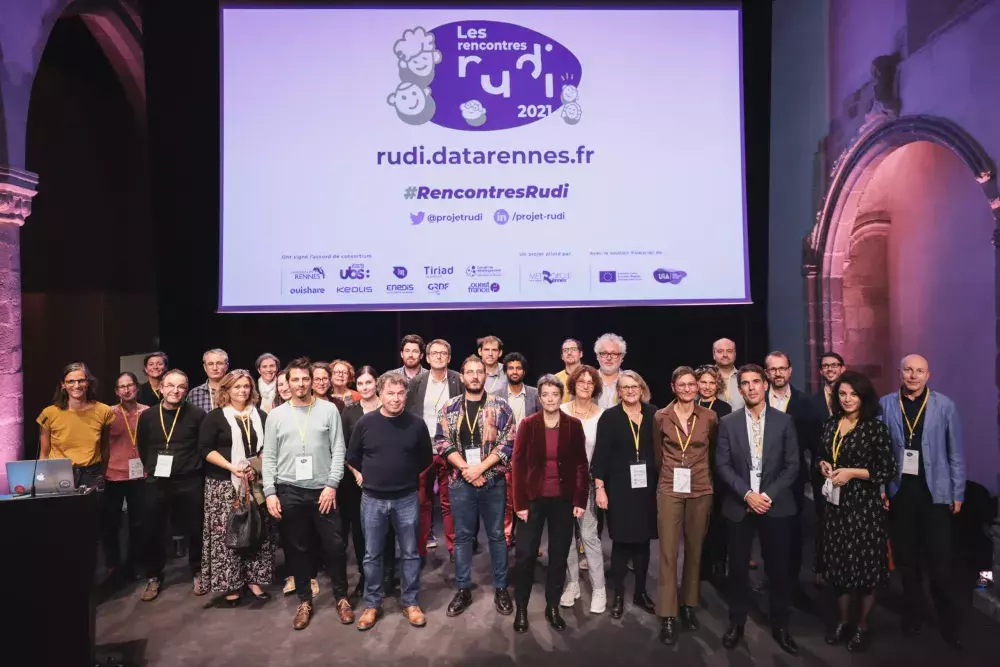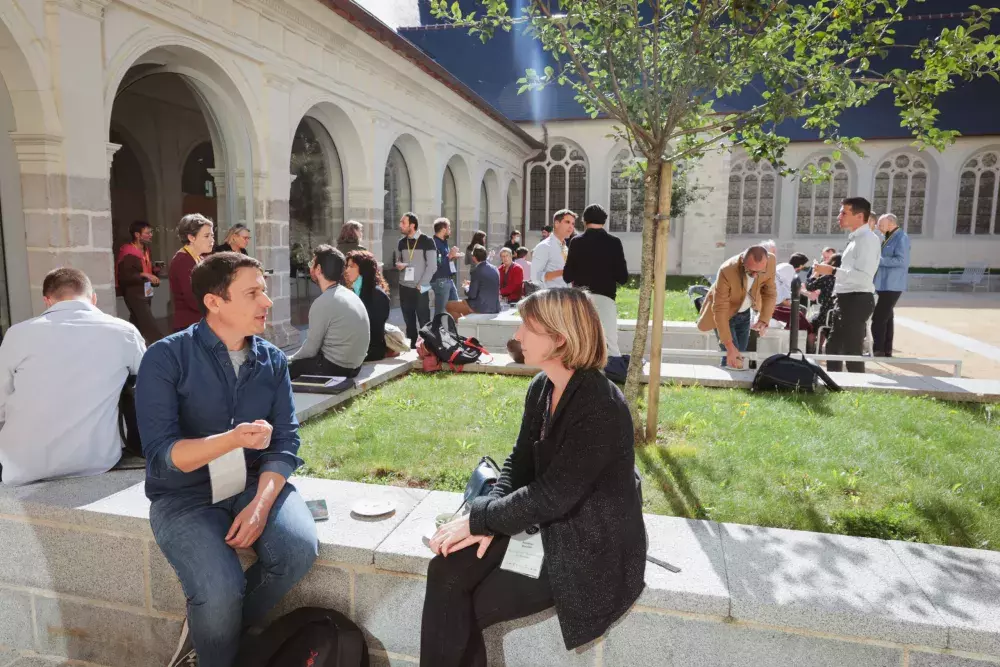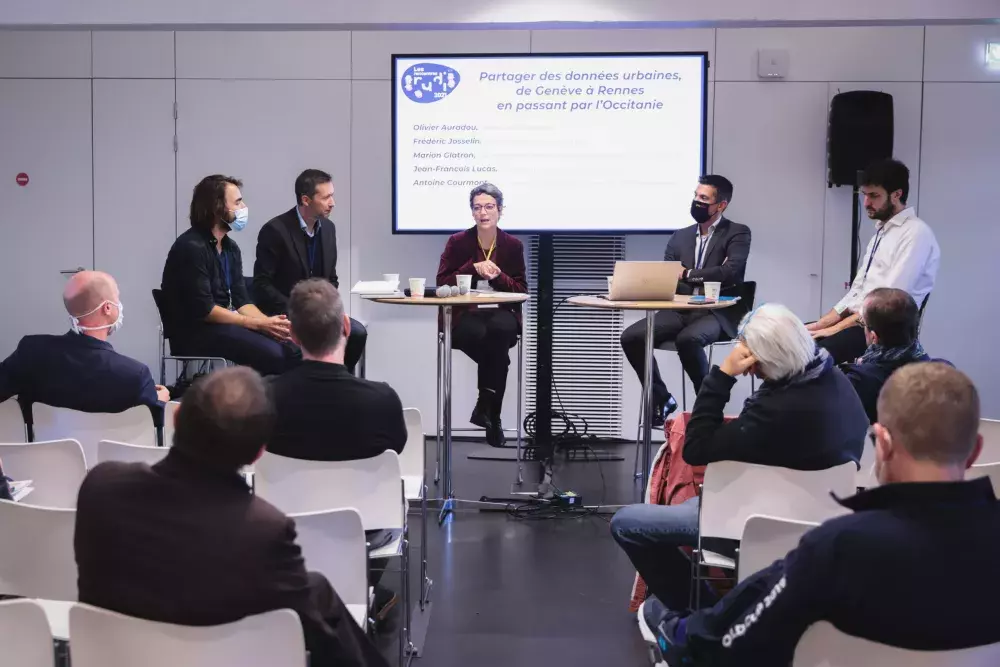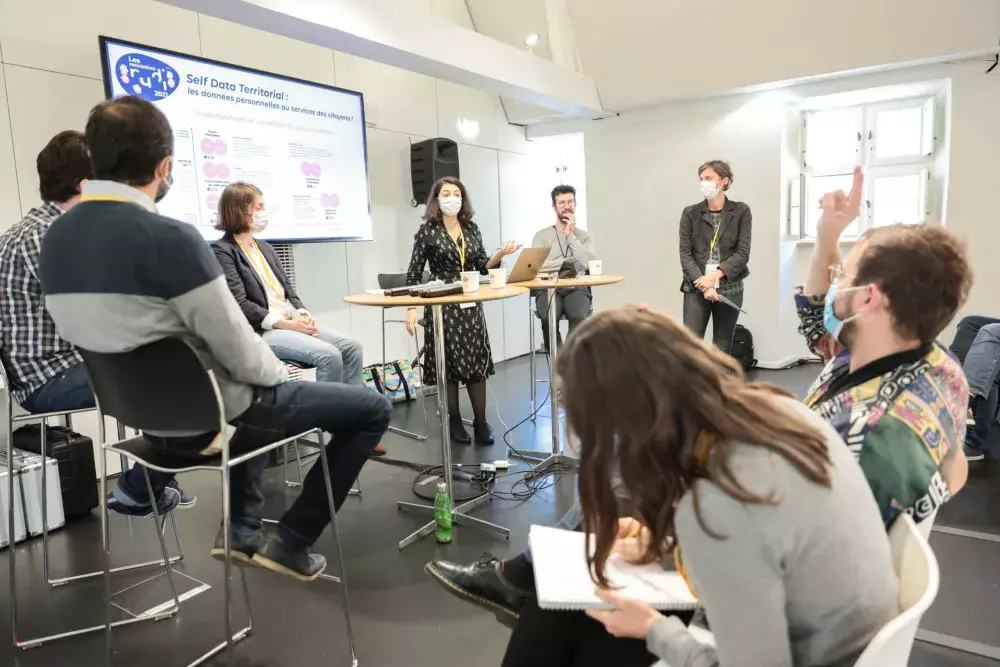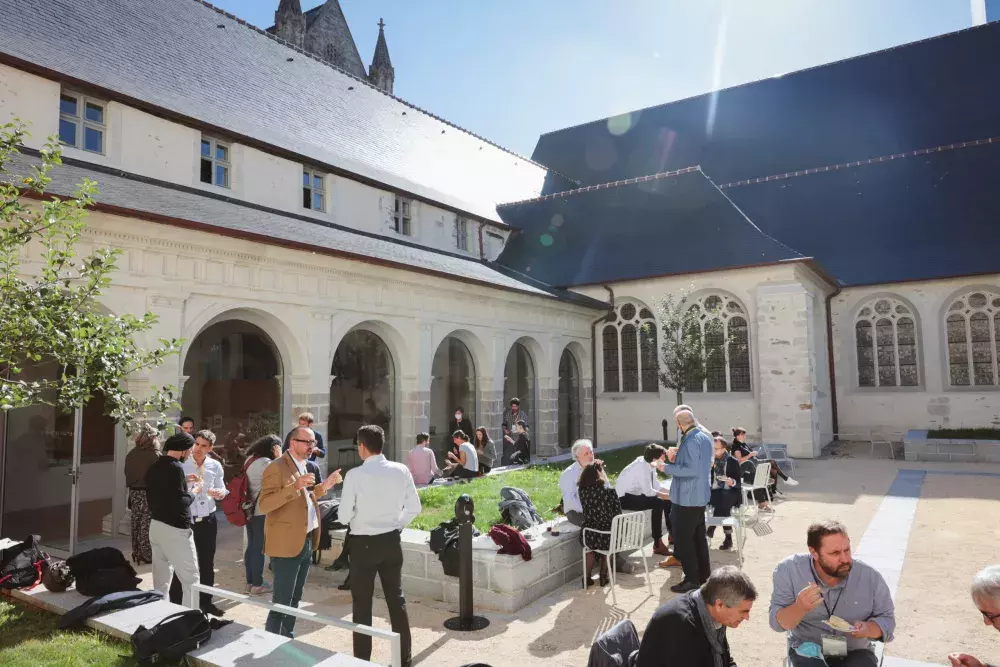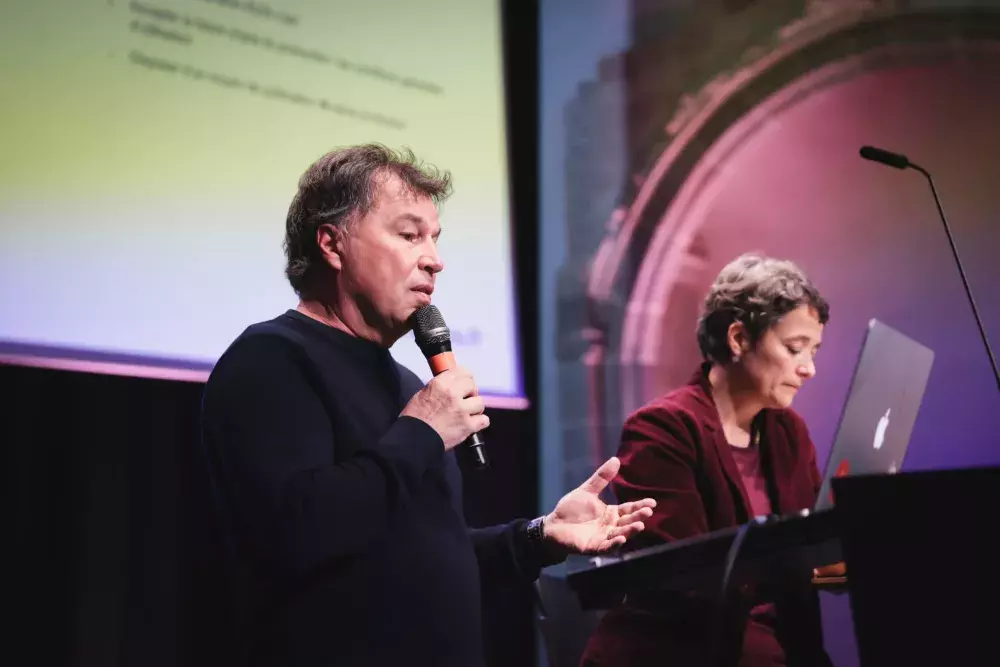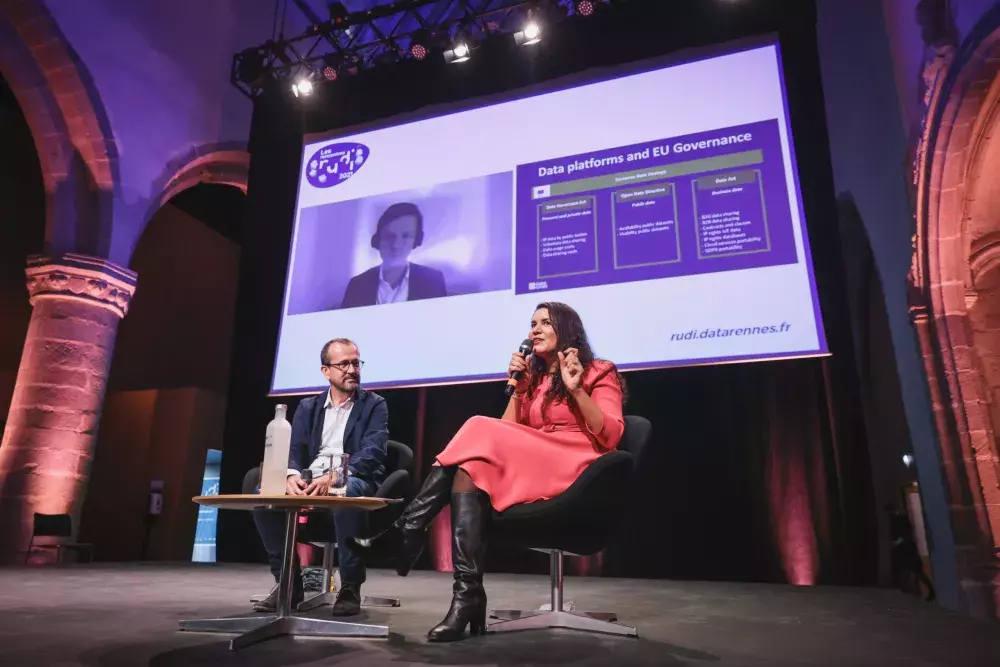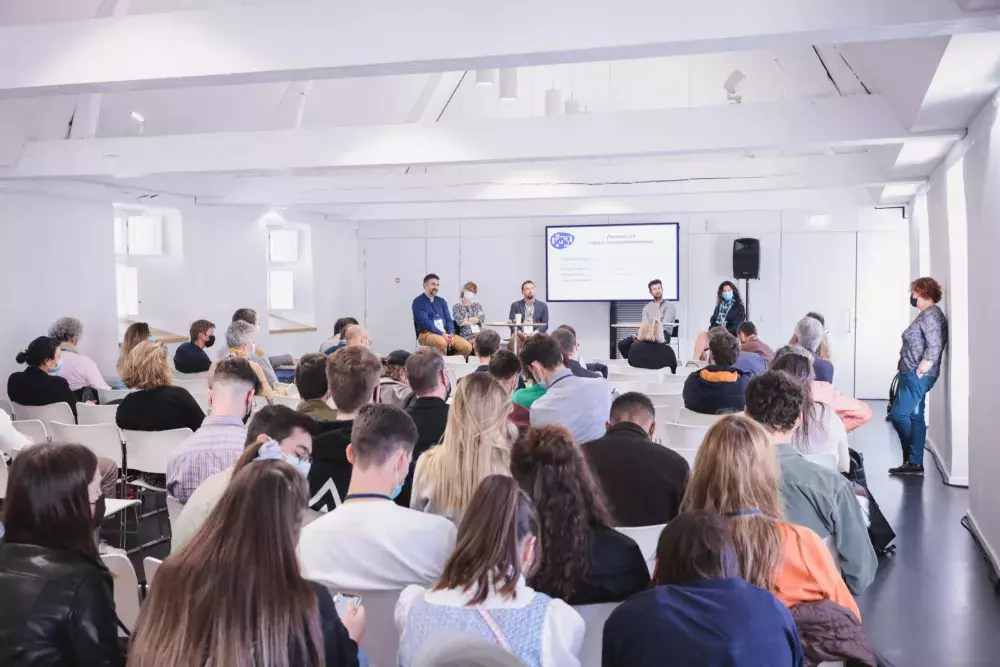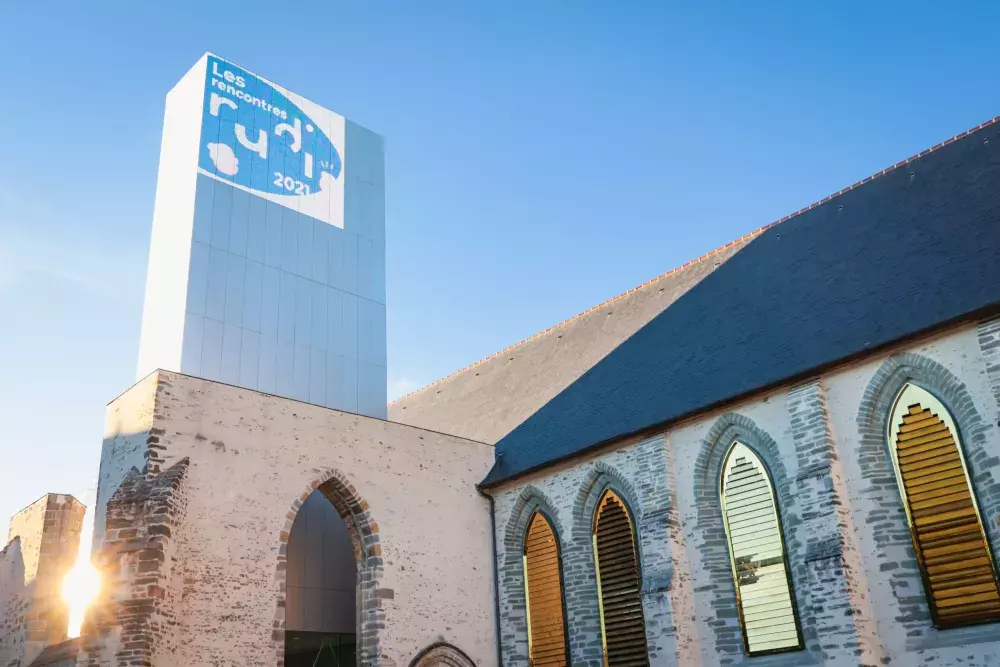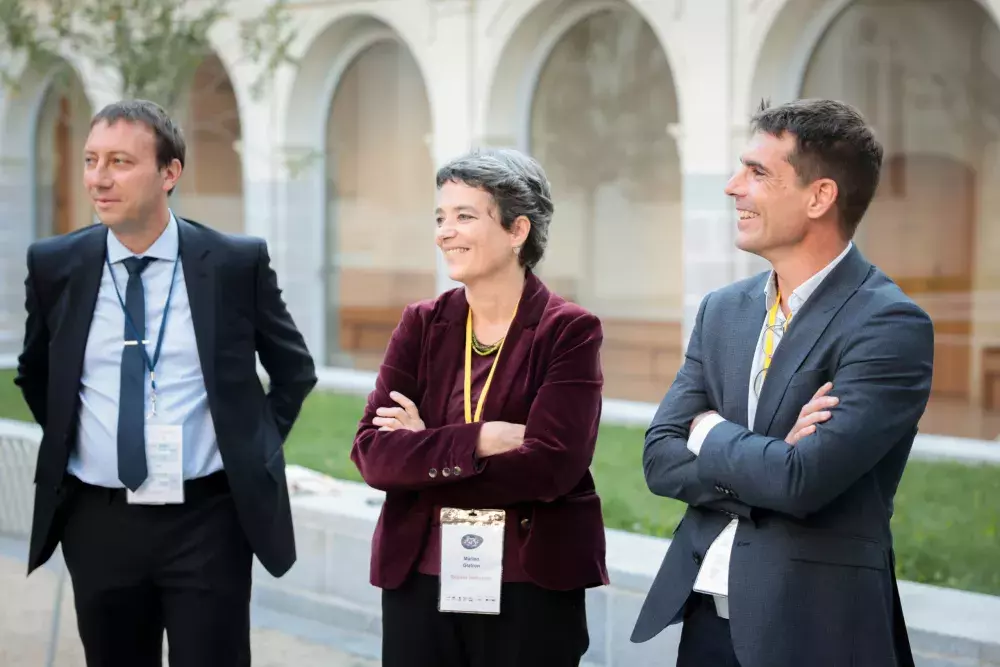RUDI - Rennes Urban Data Interface Journal 2: get an update about Rennes project
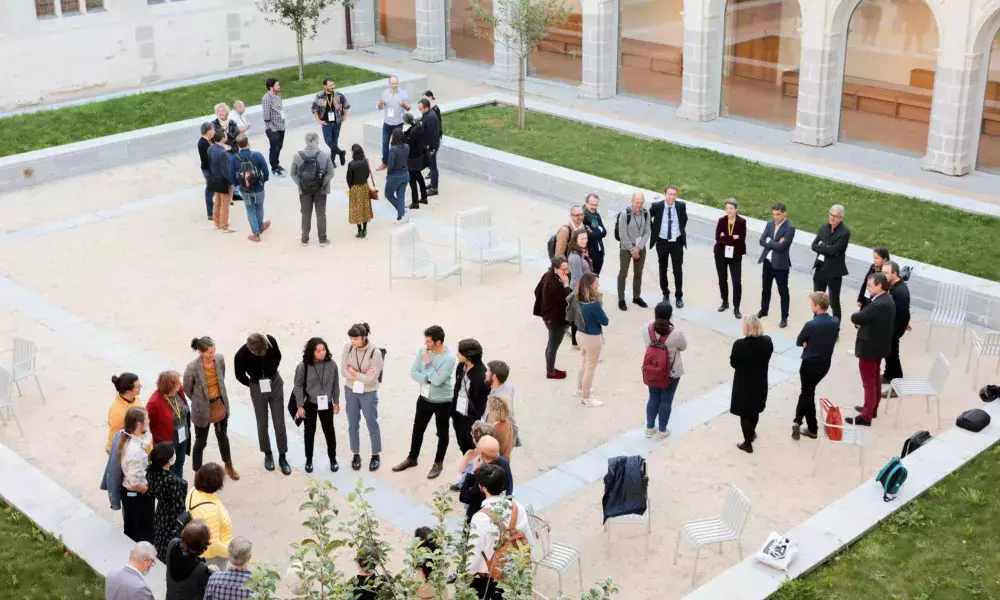
Executive summary
The main narrative about data in our modern societies is characterised by anxiety. Datafication is usually associated with the emergence of surveillance and the over-exploitation of personal data by digital platforms.
What if one could use data for the public interest? What if citizens could benefit from more data sharing at the local level? What would the role of local public authority be in making that happen?
These are general questions that go far beyond the perimeter of Rudi. Still, the ambition of Rennes Urban Data Interface is to design and implement solutions that will make data sharing for public interest easier and more respectful of individuals and organisations.
Since the publication of our first journal, Rudi became even more concrete with the launch of the beta version of the sharing platform and the selection of six projects on several topics (air quality, construction waste management, local businesses, data literacy, …). There is now little less than one year until the end of the financing period by UIA.
In this journal, we analyse a series of challenges faced by Rudi. We also note the solutions Rudi implemented to overcome these challenges and manage different expectations between partners. One can say that Rudi is already a success because it gathers a vibrant community, as illustrated by the 200 people attending Rudi's flagship event in October 2021. Rudi's partners have already identified the challenges awaiting the final stretch: developing inclusive and sustainable governance, reinforcing the data catalogue with more restricted access data (the raison d’être of Rudi and its main differentiator with the open data approach) and preparing the next phase after the period financed by the UIA.
The main narrative about data in our modern societies is characterised by anxiety. Datafication is usually associated with the emergence of surveillance and the over-exploitation of personal data by digital platforms.
What if one could use data for the public interest? What if citizens could benefit from more data sharing at the local level? What would the role of local public authority be in making that happen?
These are general questions that go far beyond the perimeter of Rudi. Still, the ambition of Rennes Urban Data Interface is to design and implement solutions that will make data sharing for public interest easier and more respectful of individuals and organisations.
Since the publication of our first journal, Rudi became even more concrete with the launch of the beta version of the sharing platform and the selection of six projects on several topics (air quality, construction waste management, local businesses, data literacy, …). There is now little less than one year until the end of the financing period by UIA.
In this journal, we analyse a series of challenges faced by Rudi. We also note the solutions Rudi implemented to overcome these challenges and manage different expectations between partners. One can say that Rudi is already a success because it gathers a vibrant community, as illustrated by the 200 people attending Rudi's flagship event in October 2021. Rudi's partners have already identified the challenges awaiting the final stretch: developing inclusive and sustainable governance, reinforcing the data catalogue with more restricted access data (the raison d’être of Rudi and its main differentiator with the open data approach) and preparing the next phase after the period financed by the UIA.
Short update about the project
The past year has been a milestone in the development of the Rudi project. The project is taking shape beyond the initial circle of consortium partners. A first version of the platform has been released, and the technical architecture on the data producer side ("producer node") has been finalised. Six projects have been selected and are developing services and applications. There is now just under a year left to complete the project after the extension agreed by the UIA. Rudi and his partners are now in the final stretch, where all the puzzle pieces start to come together to build the expected project.
The platform's beta version was delivered in October 2021, in line with Rudi's Annual Event at the Couvent des Jacobins. As the Rudi team states in its annual report, this delivery helps to make the project more concrete: "Our data-sharing platform is now an actual object which can be tested, discussed and improved, which makes it a lot easier to involve new stakeholders". In fact, during the period covered by this journal, new partners have shown interest in Rudi (see the analysis of the "upscaling" challenge). The beta version of the platform has also raised some questions about articulating the Rudi platform with open data initiatives in the territory, particularly the open data platform that has existed for almost a decade now.
Rudi's ambition is clear: it aims to offer data sharing and not just open data. The main difference is the restricted access data, meaning the data that partners could exchange through the platform without necessarily wishing (or being able) to make them available to everyone. At this project stage, most of the data present on the beta version is open data, which may have raised questions. However, it must be emphasised that the Rudi project team is well aware of this issue and that the efforts in the coming months will also aim to clarify the links between the various existing initiatives and in particular the open data policy at the local level.
In IT, it is common to distinguish between the back office and the front office. Only the latter is visible to users, mainly through user interfaces. The platform, in beta version, is the "showcase" of the Rudi project. But what is much less visible (the technical architecture) is just as exciting and innovative. It all starts with a question: how to facilitate data sharing? Today, most data platforms operate on a similar model, characterised by the centralisation of exchanges. Data producers are requested to extract data from their information system and publish them on an external platform. This process of "detaching" data also implies a loss of control for the producers. Once a piece of data is published, they no longer have the possibility, for example, to go back and de-publish it. The other consequence of the centralised model is that sometimes producers no longer feel responsible for the data published on a third-party platform, for example when it comes to engaging in discussion with re-users.
The technical architecture implemented by Rudi works differently. It is based on the concept of a federation of producer nodes. Each producer who wishes to join Rudi should use their own producer node, which will allow them to share data directly from their information system. This architecture, developed by Irisa (one of the research partners in the Rudi consortium), allows the producer to keep control over the data. This possibility is all the more critical as Rudi aims to allow the exchange of restricted-access data.
The call for projects, launched in November 2020, was a great success: more than thirty project leaders applied. The jury, composed of Rudi's partners, met three times in April, June and July 2021. It selected six projects (mainly led by SMEs but also by local associations) which will benefit from financial support and dedicated coaching:
Banco (developing a national database of local shops), Democrasim (building air quality simulation models), eRudi (disseminating data culture among education and mediation professionals), Handimap (making it easier for people with reduced mobility to get around the city), Heol (promoting the development of solar energy) and Metadata (encouraging the recycling of construction waste).
- See the Zoom-In #1 for interviews with projects leaders and jury members.
The expression "no man is an island" is intended to demonstrate the extent to which we, as individuals, are in constant relationship with other people but also with our wider environment. It can also be said that "Rudi is not an island", but rather a project linked to other dynamics that go far beyond its perimeter or territory.
First of all, the issue of climate change: one notes that the majority of the selected projects are linked to this crucial global issue. Without adopting a naïve and solutionist approach (the belief that every problem has a technical solution), we can nevertheless stress that the use of data can contribute to the fight against climate change. This is the case of several projects developed within the framework of Rudi. The Democrasim project (led by the company Amplisim) focuses on air quality near waste treatment sites. This is a complex and sensitive subject: the population is not only demanding transparent information but also actions to reduce these nuisances and sources of pollution. Democrasim aims to develop simulations for decision-makers and managers of industrial sites, but also facilitate consultation with the population concerned.
Another important element is Rudi's links to the European Data Strategy. In the first journal, we mentioned Rudi's policy relevance at European level. The European data strategy, announced by the European Commission in 2020, is beginning to be put in place, notably through the Data Governance Act and the Data Act. The work carried out by Rudi echoes new concepts such as data intermediaries, data altruism or B2G data sharing. This is why the Rennes initiative is nourished by regular exchanges with other cities at the European level, but also why it is an example often cited by organisations such as Eurocities.
Rudi 2021 flagship event in pictures
The annual Rudi flagship event took place on 8 October 2021 at the Couvent des Jacobins in the historic city centre of Rennes. More than 200 people participated: project partners, local actors (associations, companies), academic research and public actors (local and national public authorities). On the programme for the 2021 event: sessions on data and its uses, feedback on cooperation around data in France and Europe, and "cartes blanches" given to artists (Albertine Meunier, Filipe Vilas Boas) who work around data, among many other topics.
The annual Rudi flagship event took place on 8 October 2021 at the Couvent des Jacobins in the historic city centre of Rennes. More than 200 people participated: project partners, local actors (associations, companies), academic research and public actors (local and national public authorities). On the programme for the 2021 event: sessions on data and its uses, feedback on cooperation around data in France and Europe, and "cartes blanches" given to artists (Albertine Meunier, Filipe Vilas Boas) who work around data, among many other topics.
Challenges analysis
Political support for the project remains strong, but the leadership exercised by the local public authority, particularly vis-à-vis the partners, is slightly less open and partnership-based than initially expected.
Not initially perceived as a lever for innovation, public procurement turned out to be a source of unanticipated difficulties during the project.
The management of the Rudi project involves various departments and divisions of Rennes Métropole. The project team must manage different expectations and timeframes, both internally and externally. The annual meetings are the privileged time to communicate a shared vision.£
The participation of citizens in the design and construction of the Rudi platform remains complicated and raises political questions about representativity. But new producers are now joining the dynamic, which is very positive.
A mission to evaluate the project was entrusted to a specialised consultancy. The interim evaluation report has already informed the project's partners of the issues at stake in the project's final phase.
Annual flagship event open to everyone, regular seminars for partners, newsletters, and press relations: there are many initiatives to communicate the progress and achievements of Rudi. The expected launch of Rudi-based services should help communicate the benefits to the general public more easily.
Scaling options are multiple: territorial expansion, new producers' recruitment, and finally, the Rudi solution's transfer to other territories. But the current priority is instead to consolidate the existing system and the first version of the platform.
One can address the topic of leadership in at least two different ways. On the one hand, the political support by elected representatives. On the other hand, the oversight exercised by the local public authority - Rennes Métropole - steering the project. Rudi can draw on the active support of the elected officials in charge of digital issues - first and foremost, Yann Huaumé, VP of Rennes Métropole. He has endorsed the project's stakes for the territory. The support of Rennes Métropole's top management is also strong and visible. The deputy director-general in charge of digital issues was appointed after the project's launch. He also shares the project's ambition and is thus a sponsor of the project. On the first dimension of leadership, i.e. political and hierarchical support, we can therefore consider that Rudi enjoys a favourable environment.
The second dimension of leadership - the one exercised by the local public authority inside the partnership - has evolved during the development of the Rudi project. Thus, several actors from the local authority underline the fact that initially, they imagined a more open governance of the project than it is in reality, with more room given to the larger data producers and partners in the steering of the project. It took time to understand each of the partners' respective margins of manoeuvre. It's a fact that Rennes Metropole commits more resources and takes more risks than the other partners. "The stakes are not equally shared", as one of the local authority's actors points out.
How can we explain this difference between the initial idea (a very open posture) and the practices during the project? The partners interviewed mention at least three possible explanations: how the local authorities operate, the lack of territorial connections of some partners and, finally, the expectations of the leading data producers.
Some partners (excluding Rennes Métropole) mentioned the difficulty for local public authorities to adopt a leadership position in a genuinely open mode: "given the constraints on local authorities - in terms of organisation, budget but above all hierarchical workings - one may wonder whether they are best placed to take the lead in partnership mode". This remark echoes the creation, in other territories, of innovation laboratories that are both inside and outside the local authority (for example, the Erasme urban laboratory in Lyon). Such organisations are usually financed by public money but enjoy their independence when it comes to conclude partnerships, for instance.
The question of territorial foothold is also raised. During the project set-up phase, the local public authority called on players such as Ouishare, the Fing and Tiriad to contribute to Rudi. These players bring their reputation and expertise to the project. They are involved in numerous projects all over France and even, for some, internationally. In this respect, their participation in Rudi is an opportunity for the project. But these three actors also have in common that they are not based in the Rennes area. This lack of territorial grounding can be seen as a strength (they are not involved in the interplay of local actors). Still, it also generates conflicts of interpretation on how activities should be implemented, and can be seen (as invoked more or less openly by the local public authority), as a limitation of their capacity for initiative ("they are off the ground"). Furthermore, it bears the risk that local associations feel that they are excluded from the discussion.
Finally, the last reason given to explain the change in attitude is linked to the expectations of large data producers. As one of the project's internal actors put it, "the big partners expect Rudi to deliver something finished - a platform - rather than participating in or influencing its design".
One of the lessons learned is that the choices made at the initial set-up of the project (for submitting the UIA application) have significant consequences later on, for example, the integration of partners with strong territorial roots. Given the time required to draw up such a project, it is not surprising that the partners mobilised are among those already involved in previous projects (see on this subject the article "Rudi, climbing the learning curve"). However, care must be taken when setting up the tasks to find the right balance between the 'usual suspects' and new actors, who will also have the capacity to bring in new ways of working. Nor is it shocking that the governance of an innovative project should evolve throughout the project and its learning process.
Rudi did not implement very innovative approaches to public procurement. For contracts related to software development, Rudi used negotiated agreements through the public sector procurement agency (UGAP), which helped simplify the purchasing procedures. Public procurement was not seen as a lever for the project, but it became a hurdle. Indeed, considering the funds committed, it was necessary to resort to the competitive tendering procedures at the European level, which made the administrative tasks considerably heavier. This challenge demonstrates that it is not easy to embark on different functions and expertise within the authority, including the legal aspects of public procurement. More active support from the UIA in this area could be beneficial.
On the contrary, the call for projects' success shows the interest in adopting different procedures and approaches, which encourage the co-construction of solutions with the project leaders.
Unlike most cities of equivalent size, which have often set up a single department in charge of digital, several departments of Rennes Métropole contribute to defining and implementing the digital policy at the local level. In concrete terms, this is reflected in the multi-actor ownership of the Rudi project, which mainly involves the new department of data, ecological transition and resources, and the department in charge of the geographic information system (GIS). Remarkably, Rudi is not the only project with a digital component to be carried out by this cross-departemental team. As one observer noted about this multi-actor mechanism: "we can see that these people are used to working together".
One could emphasise that this choice of multi-actor management also generates additional constraints. The Rudi team must coordinate internally (between the directorates and departments directly involved) and with the other departments of the local public authority (for example, those in charge of the information system, roads or waste). And all this, of course, in coordination with the other project partners.
The project management has succeeded in setting up coordination and steering structures (steering committees, operational committees, etc.) that are fully functional after having sought the proper organisational mode during the early stages of the project. The challenge of a gap in expectations (some people expect a finished product rather than being allowed to help define and build it) has already been mentioned concerning the major data producers. But this problem is also present in some of the local authority's internal departments, whose maturity levels in the data sharing and use process may be quite different.
Therefore, project management must constantly play the role of an orchestrator to bring everyone's expectations and timeframes into line.
Among the lessons drawn from this challenge, we note the importance of the collective moments that constitute Rudi's flagship event. Their preparation involves the cross mobilisation of the different Rudi's actors. And the sequence allows everyone to have an overall vision of the progress of the project and share this vision with the actors of the territory (and some other regions).
The participatory approach is one of the main implementation challenges facing Rudi. The participation of citizens and users is still complicated for many reasons.
The first reason, already mentioned, concerns the management of diverse expectations and the willingness to engage in co-construction processes, which requires both resources and a clear vision of the returns to be made from this investment. The second reason is that data sharing is still relatively obscure for most citizens. Thus, the Rudi project is constantly navigating between, on the one hand, the desire to initiate a local dialogue on personal data (in a data literacy approach) and, on the other hand, the willingness that this exchange should provide concrete, actionable and valuable inputs for the platform's design.
This tension between acculturation to the topic (in essence over a long period) and participation in co-implementation (by necessity over a more limited time) is not easy to resolve at first glance. Finally, the last reason given is the question of representativity. Who, in the Rudi consortium, carries the voice of the citizens? Here again, several approaches coexist. For example, it can be considered that, in the classic framework of representative democracy, the citizens have mandated their elected politicians to act on their behalf. But other approaches exist: participatory democracy aims to include citizens at several stages of the design of public policies. (For example, in 2021, the city of Rennes has launched a citizen debate on the deployment of 5G in the area). The fact that the initial round of stakeholders did not include many local associations is an added difficulty.
At the launch of the project, the Rudi management team had theorised three possible roles for citizens: inhabitants (who live in the territory and can, if they wish, share their data), users - consumers (who use the services developed with Rudi) and finally citizens (who therefore can exercise their rights). This comprehensive framework provides a clear description of the different roles. But it makes citizen participation in the project even more complex.
This issue of the representativeness of citizens in co-implementation is not trivial. It is also at the heart of the work in progress on the governance of the future platform. Should citizens be integrated into this governance? If so, in what capacity and in what form? The next few months will be decisive in deciding this question. Political choices will have to be made.
In a very positive way, we can also highlight the interest shown by new data producers (including the rectorate of the Rennes education district, the Ille-et-Vilaine department, and the regional bank Crédit Mutuel de Bretagne). Their presence is also likely to enrich the co-implementation phase by adding different points of view.
"An evaluation that is useful to the project": this is one of the mission's objectives commissioned to the specialised consultancy SCET.
Indeed, follow-up and monitoring procedures are required to guarantee that the project progresses smoothly and that public money is being used wisely. However, they are often seen as very formal procedures ("we have to do it because we are asked to") rather than as an opportunity to inform the learning loop. The production of the annual report, according to the formalism required by the UIA, is a task that requires a lot of effort and whose relevance to the stakeholders is more or less clear. In 2021, Rudi entrusted SCET with an evaluation mission that includes producing an interim evaluation (as of first quarter of 2022). This initial work is already instrumental in clarifying the final and intermediate objectives of the project in the form of an objective tree. This tool allows the visualisation of the expected impacts (production of high-quality, efficient and accessible services for the territory's citizens) as well as the set of desired results (for example, the platform attracts project leaders who create new services thanks to the data, the platform has found a viable economic model). The interim evaluation report, to be published in the following weeks, will provide a comprehensive overview of the project's progress, work package by work package and overall.
The annual Rudi flagship event took place on 8 October 2021 at the Couvent des Jacobins in the historic city centre of Rennes. More than 200 people participated in this event which attracted a large audience: project partners, local actors (associations, companies), academic research and public actors (local and national public authorities). Remarkably, these annual events also attract participants from all over France. On the programme for the 2021 event: sessions on data and its uses, feedback on cooperation around data in France and Europe, and "cartes blanches" given to artists (Albertine Meunier, Filipe Vilas Boas) who work around data. A meeting on data governance brought together several local authorities from the Brittany region, also laying the foundations for the eventual reproducibility of Rudi on a broader territorial scale (upscaling). The European dimension was not forgotten, with a conference on the European data strategy, with a contribution from Eurocities. Finally, we should note that practical workshops preceded this event on data anonymisation and data mediation throughout the week.
One can underline the importance of these meetings on the mobilisation of partners and the ecosystem around Rudi. Rudi's team presented a first (so-called beta) version of the portal to the public at this event.
Nearly 800 subscribers receive news about Rudi via a dedicated newsletter. This newsletter aims to relay the progress of the project and the many events and meetings organised by Rudi's partners, such as the Rudi Live webinars. In 2021, Rudi's communication team paid particular attention to the press. A press relations agency was commissioned for this purpose. Articles on Rudi were published in the regional dailies Ouest-France and Le Télégramme and the national publications La Gazette des Communes and Smart City Magazine.
Last year, most of Rudi's partners considered that it was still too early to think of upscaling. This year, the positions are more nuanced: for some, the upscaling strategy is already at work with the arrival of new data producers. Some bring a wider territorial dimension (such as the Department of Ille-et-Vilaine or the regional bank Crédit Mutuel de Bretagne). For others, the priority is still to consolidate the Rudi project and build the final version of the platform.
Concerning the territorial expansion by proximity, the meeting dedicated to the local authorities of the Brittany Region in October 2021 augurs possible collaborations. The transfer of Rudi to other territories remains, at this stage, more remote. However, it is conceivable that some of the project's software components (such as the producer node) could be taken up and adapted to other territories or other sectors of activity. However, few partners currently imagine that the platform in its entirety could be taken over "as is" by another territory.
Conclusion: the three facets of Rudi
What is Rudi? It may be surprising to ask this question in concluding this second journal. And yet it still seems relevant, as illustrated by the project's various challenges. It seems to us that Rudi is at least three elements of a different nature:
- "Rudi as an innovation project" funded by the UIA programme: as such, Rudi has a start and end date, many tasks to accomplish, and a budget to respect. It is also a consortium of partners who have agreed to participate in this project and to "build it as you go",
- "Rudi as a software development project”: one of the main deliverables is a local data exchange platform. Managing a collaborative project and managing a software development project are two objectives that require different ways of working,
- Finally, "Rudi as a local dynamic", i.e. a community that goes beyond the consortium of partners but also includes the project leaders (current and future), the citizens and all the actors of the wider territory who are intended to join this dynamic over the next few years.
These three facets constitute Rudi and are closely linked. But their time horizon can be very different. Developing software in such a changing environment while the governance of the future project is being built is not easy. The formalism of European-funded innovation projects and the need for collaboration between project partners also limit the possibility of using purely agile approaches to software development. On the other hand, the local dynamic started well before the project's funding period and will undoubtedly last after May 2023.
It seems to us that one way to measure Rudi's success, beyond achieving objectives and deliverables, will be to see how Rudi can articulate these three different facets. See you in the next journal to find out!
What is Rudi? It may be surprising to ask this question in concluding this second journal. And yet it still seems relevant, as illustrated by the project's various challenges. It seems to us that Rudi is at least three elements of a different nature:
- "Rudi as an innovation project" funded by the UIA programme: as such, Rudi has a start and end date, many tasks to accomplish, and a budget to respect. It is also a consortium of partners who have agreed to participate in this project and to "build it as you go",
- "Rudi as a software development project”: one of the main deliverables is a local data exchange platform. Managing a collaborative project and managing a software development project are two objectives that require different ways of working,
- Finally, "Rudi as a local dynamic", i.e. a community that goes beyond the consortium of partners but also includes the project leaders (current and future), the citizens and all the actors of the wider territory who are intended to join this dynamic over the next few years.
These three facets constitute Rudi and are closely linked. But their time horizon can be very different. Developing software in such a changing environment while the governance of the future project is being built is not easy. The formalism of European-funded innovation projects and the need for collaboration between project partners also limit the possibility of using purely agile approaches to software development. On the other hand, the local dynamic started well before the project's funding period and will undoubtedly last after May 2023.
It seems to us that one way to measure Rudi's success, beyond achieving objectives and deliverables, will be to see how Rudi can articulate these three different facets. See you in the next journal to find out!
About this resource
The Urban Innovative Actions (UIA) is a European Union initiative that provided funding to urban areas across Europe to test new and unproven solutions to urban challenges. The initiative had a total ERDF budget of €372 million for 2014-2020.
Similar content


